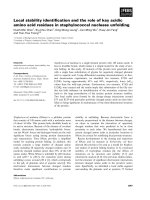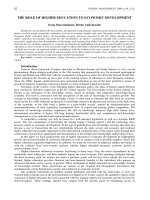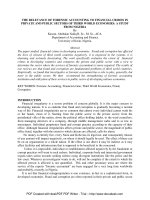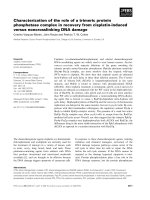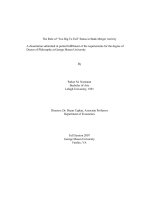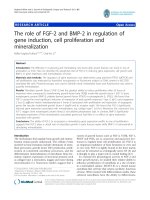the role of ''too big to fai'' status in bank merger activity
Bạn đang xem bản rút gọn của tài liệu. Xem và tải ngay bản đầy đủ của tài liệu tại đây (739.01 KB, 160 trang )
The Role of “Too Big To Fail” Status in Bank Merger Activity
A dissertation submitted in partial fulfillment of the requirements for the degree of
Doctor of Philosophy at George Mason University
By
Parker M. Normann
Bachelor of Arts
Lehigh University, 1991
Director: Dr. Bryan Caplan, Associate Professor
Department of Economics
Fall Session 2007
George Mason University
Fairfax, VA
UMI Number: 3289711
3289711
2008
UMI Microform
Copyright
All rights reserved. This microform edition is protected against
unauthorized copying under Title 17, United States Code.
ProQuest Information and Learning Company
300 North Zeeb Road
P.O. Box 1346
Ann Arbor, MI 48106-1346
by ProQuest Information and Learning Company.
ii
Copyright 2007 Parker M. Normann
All Rights Reserved
iii
DEDICATION
Dedicated in loving memory to my father, Conrad Neil Normann Sr., the first and best
economist in the family.
iv
TABLE OF CONTENTS
Page
LIST OF TABLES ………………………………………………………………….……vi
LIST OF FIGURES………………………………………………………………….… vii
ABSTRACT………………………………………………………………………….…viii
I. CHAPTER-1 1
A. Overview 1
1. Introduction 1
2. Background 4
B. Explanation/Theory for wanting TBTF Status 13
1. Moral Hazard and deposit insurance 13
2. Is the Safety Net a Benefit to Banks 17
II. CHAPTER 2 23
A. Review of Relevant Banking Developments 23
III. CHAPTER-3 MODEL 44
A. Overview of collapse and saving of LTCM 44
1. Empirical test 51
2. Results 61
3. Summary 68
B. Merger Premium Analysis 69
1. Overview of Merger Premium Methodology 69
v
2. Included variables 78
3. Data 102
4. Results 105
5. Stability Testing 123
6. Summary 129
IV. CONCLUSION 132
APPENDIX…………………………………………………………………………… 134
LIST OF REFERENCES……………………………………………………………….141
CURRICULUM VITEA……………………………………………………………… 150
vi
LIST OF TABLES
Page
Table 1 Event Study Standard OLS Results 62
Table 2 Event Study AR1 Results 64
Table 3 Event Study Single Equation Results 66
Table 4 Event Study Point Results 67
Table 5 Variable Summary Statistics 105
vii
LIST OF FIGURES
Page
Figure 1 Interest Rates Paid by U.S. Banks 9
Figure 2 Share of Total Assets Held by Banks 11
Figure 3 Large Bank Vs NASDAQ 54
Figure 4 Large Bank Vs NASDAQ One Month Window 59
Figure 5 Retail Loan Comparison 87
Figure 6 Deposit Extension Variable 127
ABSTRACT
THE ROLE OF "TOO BIG TO FAIL" STATUS IN BANK MERGER ACTIVITY
Parker M. Normann PhD
George Mason University, 2007
Dissertation Director: Dr. Bryan Caplan
This dissertation examines a linchpin of federal banking policy, the Federal Deposit
Insurance Corporation (FDIC). The main function of the FDIC is to provide absolute
guarantees on insured deposits up to a set limit. This amounts to a federal subsidy for
banks, and the greater risks banks assume, the greater the amount of the subsidy.
Attempts by policy makers to undue the undesirable aspects of the subsidy have
succeeded in limiting the extent of coverage to small banks but have codified into law
that the largest banking institutions are considered “too big to fail” (TBTF). This special
status granted to TBTF banks confers upon them a funding advantage not available to
their smaller competitors. This imbalance creates an incentive for banks to merge in
order to create a bank considered TBTF, or for existing TBTF banks to purchase smaller
banks; in either event the purpose is to capture the gains from the too big to fail status.
This potential cause of bank mergers has only recently begun to enter the banking
literature and has yet to be formerly tested. The purpose of this dissertation is to both
layout the economic theory and to test empirically the role of too big to fail status in bank
merger activity.
1
I. CHAPTER-1
A. Overview
1. Introduction
Part of the 1991 FDIC Improvement Act created explicit protections to prevent
the failure of megabanks if their collapse would undermine the stability of the overall
economy. As a result some consider that all deposits held in megabanks to have
government backing, not just those covered by the standard FDIC limit of $100,000. This
grants to banks considered too-big-to-fail (TBTF) a funding advantage in the market for
deposits, which their smaller counterparts can not exploit. This creates an incentive
whereby banks may desire to become larger, not for scale-economies, but to capture the
benefits for capital funding subsidies through a legal construct. Because these benefits
can be captured through merger activity, the 1991 act may have inadvertently contributed
to the recent increase in bank consolidations. Banks in an effort to achieve TBTF status
may combine with another large bank to reach the required threshold, or banks that are
already TBTF may extend that benefit by acquiring smaller banks below the threshold. If
true, this environment may result in a higher acquisition price, or a merger premium, for
the target bank if the combined entities, or the acquiring bank, are considered TBTF.
2
I extend the existing merger premium analysis by testing to see if TBTF status
accounts for a higher premium (ratio of the acquisition price versus the bank’s book
value) all else equal. The merger premium is understood as a value above a given ratio,
generally the price paid relative to the bank’s book value. Theoretically, certain
measurable variables such as income growth or local market conditions will influence the
size of the ratio. There is a significant amount of prior research that has tested for factors
affecting the merger premium (Palia 1993, Rhoades 1987, Cheng, Gup, and Wall 1989,
Benston, Hunter, and Wall 1995, Fraser and Kolari 1987, Esty, Narasimhan, and Tufano
1999, Beatty, Santomero, and Smirlock 1987) but none have controlled for potential
TBTF effects. Work by Shull and Hanweck (2001) and Berger et al (1999) do
specifically discuss the potential impact from TBTF but neither paper fully develops the
theory or empirically test for a TBTF effect.
Kane (2000) lays out the discussion for the effects from TBTF status but fails to
test it empirically due to the limited number of observations involving large banks. Kane
tests separately the stock return on each acquisition controlling for several factors, and to
then compare the reactions across banks of a similar size by grouping the coefficients
according to asset class. But because of the small number of mega-mergers he is left with
no useful statistics on this class size.
Instead of using an event study an alternative is to incorporate a TBTF variable in
the merger-premium models. The inclusion of the variable removes the data limitation
imposed by Kane’s methodology because the TBTF effect should occur in all
mergers/acquisitions where at least one of the parties (or post-merger, the combined
3
parties) exceeds the threshold. By including all acquisitions the number of potential
observations is greatly increased because it includes not just so called megamergers, but
also all of the purchase activity by TBTF banks. So for example, if an existing TBTF
bank purchases a small rival, this is an extension of the implied guarantee to the deposits
of the small bank. Therefore, in a competitive banking market, all else equal, a TBTF
bank will be willing to pay more for a target than a non-TBTF entity.
1
Apart from the merger premium model I also look for evidence of TBTF benefits
by investigating the outcome of the bailout of Long Term Capital Management. Long
Term was a massive hedgefund that collapsed under the weight of poor investment
decisions amidst an uncertain economic environment. The impending collapse of the
fund sent ripples of concern throughout the investment community. The concern was
evidently great enough that the Federal Reserve Bank of New York rather then let the
fund fail, chose to get involved and help orchestrate a bailout. The reasons given to the
rescue were largely due to the funds size and the potential impact on the community as a
result of its collapse. In effect the Fed was saying that the fund was too large to let fail.
This rescue of a non-bank based on its size and potential impact on the markets would
likely solidify in the minds of investors that certain entities are in fact too large to let fail.
I look to see if the stock prices for the nations 10 largest banks are favorably impacted by
the Feds involvement in the securing of Long Term Capital. If the largest banks (those
considered under the potential TBTF umbrella) saw their relative stock prices rise, this is
1
The assumption of a competitive bidding market implies that the rents from the extension or creation of
the TBTF guarantee are applied to the target firm.
4
evidence that the market saw the Long Term bailout as further confirmation of a federal
TBTF policy.
The results from the two models are generally reassuring; while the event study
shows scant evidence that the ten largest banks appear to have benefited from the Long
Term bailout, the benefit of a TBTF policy does not show up in the merger premium
model. In general, the results of the model are consistent with a competitive and efficient
bank merger market where strong growth, quality management, risk diversification, and
product market extension result in higher merger premiums. Meanwhile the results reject
effects such as TBTF or bandwagon effects where banks overpay during times of heavy
merger activity. These results are reassuring in that it offers evidence that the massive
U.S. banking industry with thousands of participants and hundreds of annual mergers is
dynamic and competitively efficient.
2. Background
Congressional response to the banking crises caused by the Great Depression
resulted in a nation wide safety net that guaranteed deposits with the full faith and credit
of the U.S. government. It soon became apparent however, that the government safety
net removed the oversight role of the market in assessing the risk of banking institutions.
The moral hazard created by the safety net enables banks to increase the risk of their
investments without having to increase the rates they pay for deposit liabilities. Because
depositors know with absolute confidence that their money is safe up to the insured limit
they do not require a risk tradeoff based on the financial health of the bank. Other market
5
factors are not necessarily sufficient to constrain bank risk taking. Shareholders want the
banks to maximize risk in order to gain the largest possible return, and themselves are not
as concerned with risk as they can sufficiently diversify through a balanced portfolio.
2
One might then argue that uninsured deposits would force banks to make risk return
tradeoffs, as uninsured depositors would demand higher interest payments to compensate
for their greater risk of loss. But observed behavior of the FDIC has demonstrated to
investors that the government does not just protect up to the insured limit, but in fact
essentially guarantees deposits regardless of size.
The protection beyond the insured limit, while not stated in fact, came to be
believed implicitly as a result of the actions by the Federal Deposit Insurance Corporation
(FDIC), the main regulatory body responsible for overseeing banks. The FDIC has
largely used purchase and assumption transactions as a means of dealing with a failed
bank or thrift. A purchase and assumption, or P&A, is a process whereby a healthy bank
acquires the failed bank’s assets and takes on all of the failed bank’s liabilities.
3
But the
FDIC, in order to encourage the transaction absorbs the losses of the failed bank rather
than having the acquiring bank pay for them. The acquiring bank then takes on all of the
liabilities, including large uninsured deposits. In this manner the protected status of
2
Investors can diversify against the risk of the bankruptcy of any given bank by owning a portfolio of bank
assets. This enables them to diversify against the specific risk of a single bank, while still capturing the
overall above market returns from a subsidized banking sector.
3
A purchase and assumption transaction is a process “whereby an insured bank purchased certain assets of
the failing bank and assumed all deposits, insured and uninsured, with the FDIC providing financial
assistance to fill the gap between liabilities and assets.” Testimony of Treasury Under Secretary For
Domestic Finance John D. Hawke, Jr. before the House Banking and Financial Services Committee, April
1998.
6
deposits has been extended well beyond the explicit limit set by law because they are just
transferred to the new owner rather than used to pay off the failed banks losses. The
FDIC was therefore not insuring just small depositors, but virtually all of the deposits for
all domestic banks.
For example, from 1986-1991, coverage of uninsured deposits ranged from 80 to
90 percent for every year except 1987 where the rate dropped to about 70 percent.
4
Further, from 1979-89, 99.7 percent of all deposits at commercial banks were fully
covered.
5
That the FDIC had created an environment where all deposits at virtually all
banks were fully covered is exemplified by William Seidman, who writing in the WSJ in
1991 said;
“[The myth is] [i]n most small-bank failures, depositors with accounts over
$100,000 end up losing part of their deposits… Some people mistakenly believe
that small-bank failures usually are resolved through a payout of insured deposits–
a liquidation, where uninsured depositors and creditors suffer some loss. The
reality is that, currently, about nine out of 10 small bank failures are resolved
through purchase and assumption transactions. In a P&A, all the deposits
(including those over the $100,000 insurance limit) generally are assumed by a
healthy bank.”
6
This effectively created a banking system that was nearly devoid of depositor
oversight and had only limited stock holder monitoring. Left with simply inefficient
4
Feldman, Ron J., Rolnick, Arthur J. 1998. Fixing FDICIA: A Plan to Address the Too-Big-To-Fail
Problem. Federal Reserve Bank of Minneapolis.
5
Feldman and Rolnick (1998).
6
Seidman (1991).
7
regulators as the only safeguard, the adverse effects of such a scheme culminated in the
massive failures in the late 1980s, now well known as the S&L crises.
In an effort to correct the documented failures of the system Congress passed the
1991 FDIC Improvement Act. There were two important aspects to the new legislation
regarding the current paper; one was that the reforms specifically addressed the issue of
too big to fail status for banks, and secondly the act set out to eliminate the use of the
P&A resolution as a means for dealing with failed banks and thrifts. The essential
element of these reforms was to curtail severely the protection of uninsured deposits at
banks and thrifts.
First, the 1991 FDIC improvement act attempted to reign in universal coverage by
stating that a ‘systematic’ risk exemption was possible only where the failure of the bank
would undermine the financial stability of the economy. Only then would the FDIC be
entitled to protect all the liabilities of the bank against loss. Further, enacting the so-
called “to big too fail” exemption requires agreement from the Fed, FDIC, the Secretary
of the Treasury and the President. Additionally, FDICIA mandated a least cost resolution
(LCR) for a failed bank’s assets. This restricts the ability of the FDIC to use purchase
and assumption transactions by a healthy bank of the failed bank's assets and liabilities.
In effect, this is designed to limit the cost and risk to the FDIC and prevent complete
coverage of bank liabilities.
The intent of these reforms was to change the perception that the FDIC would
cover all of the failed bank’s liabilities. To a large extent this appears to have worked as
the FDIC allowed depositor losses at failed banks. Starting in 1992 just over 50% of
8
uninsured deposits were covered down from 94% in 1991. By 1993 the new policy was
fully in place as the FDIC covered a mere 8 percent of uninsured deposits.
7
But the
success of the reforms may have merely undermined depositor confidence in small banks
thereby creating a competitive advantage for those banks considered too big to fail. The
chart below shows the average interest rate paid on large denomination time deposits by
bank size. Since large deposits exceed the $100,000 FDIC insurance limit the rates may
more fully incorporate the risk to the investor under a world absent the government safety
net. Notice that from 1988 to 1991, when there was the de-facto assumption of complete
coverage for all uninsured deposits there was no rate differential based on bank size. But
as the FDIC’s new policy became clear in 1992 and 1993 the ten largest banks began, and
continue, to enjoy a sizeable rate differential compared to their smaller counterparts. For
the period from 1993-99 the ten largest banks paid an average of 91 points less for large
deposits than did banks 11-1000. Such a large rate advantage indicates that those banks
considered TBTF receive a substantial funding subsidy from their implicit FDIC
protection.
8
7
Feldman and Rolnick (1998).
8
Additionally, claims that the rate difference results from market power are not sustainable as the rate
differential for small deposits has an opposite trend. From 1988-1994 the ten largest banks generally paid
substantially lower rates on insured deposits than the smaller banks indicating market power. In 1994
however, the gap began to narrow dramatically, to the point where for the last three years (1997-99) there
has been almost no difference.
9
Interest Rates Paid by U.S. Banks
Large Denomination Time Deposits
1988 - 1999
N/A
N/A
N/A
6 %
8 %
16 %
6 %
44 %
92 %
56 %
100 %
61 %
0.00
1.00
2.00
3.00
4.00
5.00
6.00
7.00
8.00
9.00
10.00
1988 1989 1990 1991 1992 1993 1994 1995 1996 1997 1998 1999
% Uninsured & Unprotected 11-100 101-1000 1-10
Source: Federal Reserve Bulletin, June 1997 & June 1998; Feldman and Rolnick, 1997 Annual Report, Federal Reserve Bank of Minneapolis.
Figure 1 Interest Rates Paid by U.S. Banks
Hanweck and Shull (1999) found similar rate differentials between large and
small banks that they also attributed to the implied protection stemming from TBTF.
Additionally, they found that the ten largest banks operate with lower capitalization rates
than their smaller counterparts. For 1997 the ten largest banks had average equity-to-
asset ratios of 7.39 percent compared to 10.3 percent for the smallest banks. Further they
argue that the Fed’s recent behavior to form a loan syndicate to save Long-Term Capital
10
Management has re-enforced the position that certain institutions are beyond failure due
to their position within the financial community.
9
A non-TBTF bank can achieve TBTF status only through a merger/acquisition or
by internal growth. Additionally, a TBTF bank can gain additional benefits by acquiring
a small bank thereby transferring their preferred deposit rates onto the newly acquired
small bank’s existing and future deposits. In an effort to either capture TBTF status, or
further extend that status, we would expect to see banks engaging in more merger activity
than they otherwise would. Indeed, the past decade has seen a tremendous wave of
consolidation and scores of megamergers involving banks with more than $10 billion in
assets.
It is important to study factors affecting merger activity because over the last
decade there has been considerable consolidation and a growing number of mergers
between the largest banks. During the decade of the 90s there was more than 30
completed or proposed megamergers involving organizations with over $10 billion in
assets.
10
From 2000-2003 there were more than 1,000 mergers of commercial banks
11
, of
which nearly 50 involved banks that each had assets of greater than $1 billion
12
. The
creation of a greater number of large banks expands the scope of TBTF coverage to a
larger amount of assets and potentially increases the number of banks that receive a
funding subsidy. As of 1997 Feldman and Rolnick identified 21 banks, up from 11 in
9
Hanweck and Shull (1999),16.
10
Hanweck and Shull (1999).
11
FDIC Statistics at a glance, June 2006.
12
Jones and Critchfield 2005.
11
1984, that they now consider TBTF, and that combined control 38 percent of all
uninsured deposits.
13
The chart below shows that the trend towards greater concentration
has not abetted since 1997. Indeed, as of 1999 the ten largest banks controlled 36 percent
of all bank assets, while the top 100 controlled over 70 percent. Making a conservative
estimate from these figures suggests the consolidation trend has extended TBTF
protection to 40-50 percent of all bank assets.
0.0%
10.0%
20.0%
30.0%
40.0%
50.0%
60.0%
70.0%
80.0%
1990 1991 1992 1993 1994 1995 1996 1997 1998 1999
% Held
Share of Total Assets Held by Large Banks
1990 - 1999
Ten Largest 1-100
Source: Federal Reserve Bulletin, June 1997 & June 1998; Feldman and Rolnick, 1997 Annual Report, Federal Reserve Bank of Minneapolis.
Figure 2 Share of Total Assets Held by Banks
13
Feldman and Rolnick (1998).
12
Despite the newness of the rapid consolidation in the industry the topic has
spurned significant amounts of research and study to determine the causes and
consequences. An issue not yet formerly studied is the potential impact on merger
activity from the 1991 FDICIA reforms that have lowered the funding costs for banks
considered too big to fail. There are two reasons that the TBTF funding advantage may
increase merger activity. First, two banks that individually do not fall under TBTF
protection, but combined do, have a strong incentive to merge. This additional funding
advantage is outside of other scale efficiencies; it results strictly from the benefit accruing
from the government. This suggests that much of the research that finds gains from scale
in bank mergers might actually be capturing the TBTF benefit and not the actual
efficiencies created by the merged firms. To the extent this may be true this has strong
implications for the social welfare function as the merger decision is made less on
efficiency improvements and is instead motivated by regulatory incentives.
The second type of merger is a large bank purchasing a smaller one. In cases
where the large bank is already TBTF, the small bank post-merger, will now receive the
same cost of funding benefits. This benefit only accrues to banks that are either TBTF or
would be put over the TBTF threshold by the acquisition. Thus, these banks will be
willing to pay a premium to acquire these smaller banks that, all else equal, a bank that is
not in a TBTF position could not match. If the market among large banks is competitive
the purchase price of the small bank should reflect the TBTF premium.
13
The 1990s merger wave has been studied in some depth and a variety of
explanations have been offered. But one issue that has received only limited attention and
not been formerly tested, is that banks through merger/acquisition can either achieve
TBTF status or leverage that existing status to additional deposits (Shull and Hanweek
2001, Kane 2000, Berger et al. 1999). If this is a factor in bank merger activity then it
implies that the recent wave of consolidation is fueled at least in part by a legal construct
and not by efforts to enhance efficiency. Further, studies that indicate that banks are
achieving economies of scale may be misidentifying the association, as the scale
economies may result from their implied government status and not from actual
efficiencies resulting from greater size.
B. Explanation/Theory for wanting TBTF Status
1. Moral Hazard and deposit insurance
Largely due to their highly leveraged position and the fractional reserve system
banks have long been considered more fragile and susceptible to failure than other
institutions.
14
Banks, unlike most other enterprises have little physical capital and, as
such, maintain a highly leveraged position with low capital-to-asset ratios. In the event of
a bank failure there are few salvageable assets that can be used to pay off the debt
holders, exposing them to significant losses. A second unique feature of banks that raises
14
concern is the fractional reserve system. Banks have only a small fraction of their total
deposit liabilities on hand in the form of cash to meet withdrawal demands from
customers. Under normal circumstances when the bank is solvent this setup works well
and in fact is a primary vehicle for credit and wealth creation in the economy. But under
periods of duress when the bank’s stability is brought into question, fractional reserves
make the bank particularly susceptible to severe cash shortages in the event of a run on
the institution. Thus, a seemingly solid bank could be thrown into disarray if the financial
markets in general are thought to be on the verge of collapse.
Because of the unique financial position of banks and the corresponding risk to
customer deposits various approaches to establishing deposit insurance date back as far as
1829.
15
The early attempts at the state level failed for a variety of reasons. Not until the
great depression, with the failure of 9,000 banks and widespread losses suffered by
depositors, was there sufficient momentum to create a federal safety net for bank
deposits. The Glass-Steagall act of 1933 and additional legislation in 1935 created the
FDIC as the guarantor of deposits in domestic banks.
16
A safety net supported by the full
faith and credit of the federal government assured depositors that their money was safe,
thus eliminating the risk of destabilizing bank runs.
17
But in removing the risk faced by
________________________
14
See Kroszner, Richard, “Bank Regulation; Will Regulators Catch Up with the Market?” Cato Institute
Briefing Paper No. 45, March 1999.
15
Petri, Tom and Bert Ely, “Better Banking For America: The 100 Percent Cross-Guarantee Solution,”
Common Sense, Fall 1995.
16
FDIC, Important Banking Legislation,
17
Besides the well-known benefits of deposit insurance there are two other features of the current system
that are considered to provide a subsidy. One is the guarantee of inter-bank payments through the Fed's
payment network. This is typically considered to provide a subsidy as a result of the guarantee that would
15
depositors, it also relieved them of their oversight role to make sure that the financial
institutions that kept their money were financially sound. Banks no longer faced with the
prospect of losing depositors or having to pay them higher rates to compensate for greater
risk created the opportunity for moral hazard.
Moral hazard in the context of banking occurs because FDIC insured banks are
able to take on risk without having to pay higher finance costs or premiums
corresponding to that level of risk.
18
This results from two factors: 1) customers do not
face any additional risk because the full faith and credit of the US government back their
insured deposits, and 2) despite recent reforms the FDIC does not price insurance
according to risk. Therefore, despite the underlying risk of the bank’s investments the
deposits they accept are priced at a risk free rate that is not offset by an efficient insurance
pricing mechanism. To the extent that banks derive a subsidy from the safety net it
materializes in reduced interest rate payments required to attract depositors. The total
benefit from the subsidy is the difference between that rate and the rate they would be
required to pay if they had to compensate depositors fully for the true level of risk.
The actual size of the subsidy is difficult to measure because it depends on the
characteristics of each bank as well as conditions within the overall economy. Banks that
are near insolvency derive substantial benefits from deposit insurance, but institutions
that are well capitalized with high franchise values or risk-sensitive managers interested
________________________
come at a substantial cost in the private market (see Ely (1999) and Testimony by Alan Greenspan, March
19, 1997). The second is access to the Fed discount window that grants banks immediate access to liquid
funds. Both of these features provide substantial benefits to the banking industry, but the largest single
cause of the subsidy is deposit insurance.


